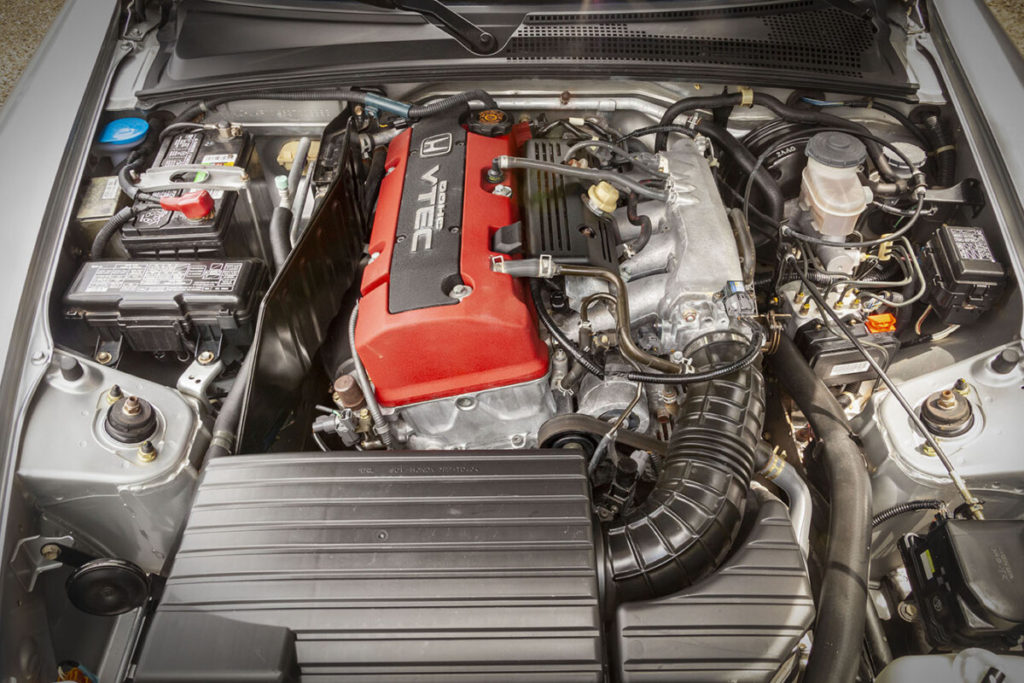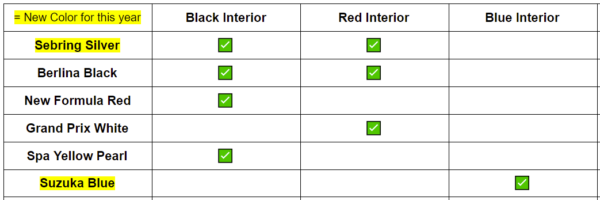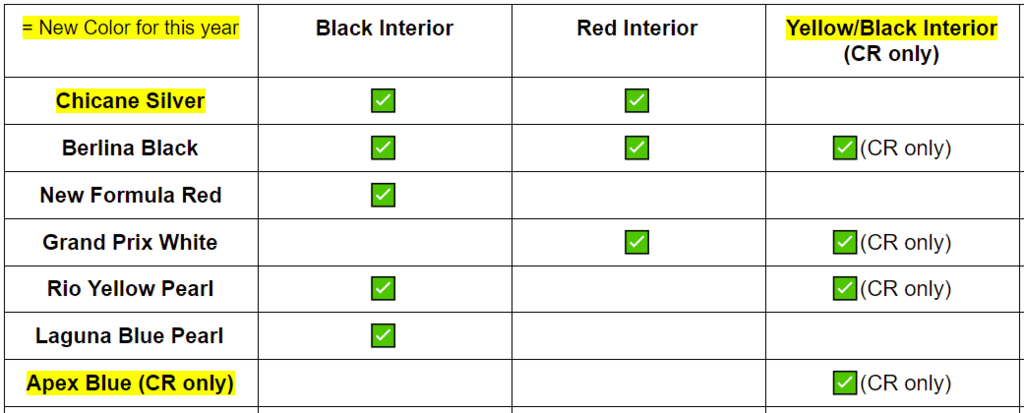
Sponsored Post Contributed by NewOldCars.com, a car finding blog and classifieds.
“Industry Insights” is a new web series from American Collectors Insurance in conjunction with Andre Clemente, founder of NewOldCars.com. We look forward to sharing Collector related insights, vehicle spotlights, buying tips, & much more. Enjoy!
The S2000 needs no introduction. It took the world by storm when it debuted with a 9,000 RPM 2.0L F20C engine that broke the record for the highest specific output of any naturally aspirated production engine in the world (120bhp per liter). It was such a phenomenal achievement that 10 years would pass until another carmaker (Ferrari) could beat the S2000’s specific output (125bhp per liter with the 458).
Amazingly, the F20C operates cleanly enough to qualify the S2000 as a Low-Emission Vehicle (LEV)! Honda reliability, affordable parts, track-capable, and high resale value – how much more can you ask for? This explains why everyone wants one, and it’s why Honda kept it in production for nearly 10 years.
So the question is … what are the best years to buy?
In truth, there is no definitive “best year” S2000. On paper, the 2002+ models are the ones to go for, as these have glass rear windows, revised suspension, etc. In general, buyers tend to lean toward the post-facelift years (2004+, designated “AP2”), however, there is absolutely nothing wrong with an “AP1” S2000 (2000-2003) – especially since these early cars rev to a stratospheric 9,000 RPM. And that leads us to the most noticeable difference between the AP1 and AP2: drivability and handling.
For the AP2, Honda bumped the displacement of the engine from 2.0L to 2.2L by increasing the stroke. This necessitated a name change to F22C (for 2.2L) replacing the F20C (2.0L). While both these engines were rated at the same horsepower, they felt noticeably different from the driver’s seat.

The reality is that increasing the engine’s stroke will lead to an increase in piston speed. This in turn increases drag within the engine, since piston movement is responsible for most of the friction in an engine.
Unfortunately, friction happens to be one of the biggest enemies of high RPM engines. The F22C is no longer an oversquare design, as the stroke (90.7 mm) is now larger than the bore (87mm) – high RPM engines tend to favor the opposite. In the end, the increased stroke required Honda to lower the redline to 8200 RPM (down from 9,000).
However – the increased stroke provided a bump in torque to 162 ft lbs (up from 153 ft lbs), and it spread the powerband to a more usable duration of the RPM range. Overall, the new F22C made the thrust between 1000 and 8000 RPM feel slightly stronger than the earlier AP1 models. No longer was everything focused up top above 8000 RPM like it was in the F20C.
In addition, the AP1 is known for being a bit twitchy when pushed hard – especially in the rear. Combined with the lack of driver aids, the AP1 is an edgy car at the limit, and Honda made revisions to the suspension as years went on to refine the driving experience. However (depending on what year), this involved a handful of electronic nannies and safeguards that hardcore enthusiasts prefer to live without.
So there’s your choice – do you spend less money on the more raw, high-strung AP1 that requires you to rev the snot out of it (basically a “Type R” in a sense), or do you spend extra for the additional low-RPM grunt, increased safety, updated styling, added features, and improved around-town drivability of the AP2?
Even after you’ve decided between an AP1 and AP2, you’re going to want to spec the car just right … but the job isn’t so clear-cut.
As an example, for such a simply color palette, Honda made enough erratic changes that it’s difficult for the average person to determine exactly what color combos were available each years. Some colors disappeared, then reappeared, or some colors were only available with a certain color interior for one year. And how about the fact that interior colors (other than black) could either be full-color interiors, or half black. It’s a bit confusing … and frustrating to follow.
Plus, Honda made thousands of revisions throughout the car’s lifespan (most occurring in 2004 and 2006), and as such, not all of them are clearly listed in the factory press releases.
Thankfully, we have you covered. While it would be ridiculous to list 100% of the changes that occurred in 2004 and 2006 (some details are just too small and insignificant to care about), the list of model year changes below is more comprehensive than anything you will find in any other buyer’s guide – and it even includes the available color combos for each year:
Honda S2000 Model Year Changes
Including color changes by the years
Paint Color Notes:
- Formula Red could only ever be paired with the Black interior
- Suzuka Blue could only ever be paired with the Blue interior
- Laguna Blue Pearl could only ever be paired with the Black interior
- The only year Grand Prix White could be paired with Black interior was in 2006. Otherwise, it could only be paired with a Red or Tan interior
- 2002 is the only year Silverstone Metallic was not available
- 2002 and 2003 are the only years you could order the full Red interior (rather than Red/Black combo)
2000:

2001:

- The S2000 finally includes a clock, located in the radio. Honda omitted a clock from the 2000 models to stay in line with the bare essentials “race car” theme
- An emergency trunk release is added
- Wind deflector is now standard
- First year of the removeable hard top option
- Floor mats are now standard (first year of red floormat option
- New factory accessories available this year include rear spoiler, front lip, and side strakes
2002:

Note: Both the red and the blue options are now full-color interiors. The whole interior is now red, for example, rather than just the seats, carpets, and door panel
- The rear plastic window replaced for a glass piece
- Significant suspension changes occur: spring rates are increased, smaller diameter anti-roll bars, and revised shock absorbers. Steering feel is improved, as well as handling progression at the limit
- 2002 is the only year Silverstone Metallic was not available
- The stereo controls and sound system are upgraded (now 30 watts per channel, rather than 20)
- Shift knob is now leather wrapped, as the previous aluminum shift nob would get too hot in the sun
- New higher capacity clutch disc
- The entire center console is now wrapped in leather (instead of carpet)
- More powerful A/C fan (2nd and 3rd fan speeds are noticeably stronger)
- Chrome trim rings are added to the tail lights
- Metal trim rings are added to the inner door handle
- Dashboard trim and misc interior trim are upgraded to higher quality materials
- “Revised transmission for smoother and quieter shifting” (Honda’s words) as well as an ECU re-map (2002-2003 S2000’s typically put down an extra 10whp)
- Many of the buttons are redesigned or relocated
- The tach indicator line is now white and the scale connected by a solid white arc line
- Carpeted floor mats feature an additional post to help secure them
- Tiny storage pockets are added to the doors
- Metallic accents were added throughout the car, with much of it replacing the black plastic found on previous cars
- The dead pedal finish now matches the other pedals
2003:

- Final year of hydraulic steering
- Final year of the AP1
- No changes occurred this year other than a new Tan interior color for Grand Prix White only
- Silverstone Metallic returns to the options list
AP1 Exterior (2002)


AP2 Exterior (2004)


2004:

- The S2000 received significant changes for the 2004 model year, earning it the AP2 designation (replacing AP1). Honda claims over 2,000 changes were made to the S2000 this year alone
- This was the mid-cycle facelift, so numerous cosmetic changes occurred (exterior lighting, bigger wheels, interior design updates such as new steering wheel, etc)
- Bigger engine with lower redline, electric power steering, softer ride, shorter gear ratios, bigger wheels, and more. Peak power output remains the same, despite a noticeably different powerband. All major 2004 changes can be found in Honda’s 2004 press release
- New multi-spoke 17″ wheels are 1/2″ wider in front and 1″ wider in the rear
- New electric steering with updated steering gear ratio to match the new suspension/tires changes
- The notorious rear bump steer at the limit has been addressed: rear toe is reduced, and the rear roll center was lowered to 92 mm (from 101 mm). This improves road holding under full suspension compression (severe body roll, squat, etc)
- Steering is improved in accuracy, effort, and feel. Ratio is reduced from 13.8:1 to 14.9:1, and lock-to-lock increases from 2.4 to 2.6 turns
- Brake pad material is now metallic (greater frictional stability at high temps), increasing fade resistance and stopping force at the limit
- Master cylinder ratio is now 6.5 (vs 6.0), resulting in a more solid pedal feel during long, aggressive brake applications. Brake pedal feel is improved, with less pedal travel is required than before
- ABS system is updated to improve stability over uneven surfaces. The ABS unit itself is now smaller and lighter
- Compression is increased from 11.0:1 to 11.1. Valve timing is revised to boost mid-range torque
- Highway fuel economy rating drops by 1 mpg
- An extra horizontal cross brace is added at the nose of the front subframe
- All crucial crossmember joints have been reinforced
- Existing chassis braces are reinforced, as well as the rear wheel arch bulkhead
- Upper front suspension link brackets are now heavy duty, reducing flex
- The AP2’s curb weight is 25 lbs higher than the previous year AP1 (now 2835 lbs)
- New throttle has reduced travel (10 mm) and increased pedal effort, thanks to a smaller throttle body drum
AP1 Interior (2000)

AP2 Interior (2008)

2005:

- Per Honda’s 9/1/04 press release: “There are no changes to the 2005 Honda S2000.”
- Final year of a throttle cable. The following year (2006) is updated to drive-by-wire throttle
- Final year of the Tan Interior (which could only be paired w/ Grand Prix White)
2006:

Note: This is the only year that Grand Prix White could be paired w/ a black interior
2006 is the final year of Sebring Silver and Suzuka Blue, as well the Blue interior
- First year of drive-by-wire and traction control
- First year of daytime running lights
- ECU is revised so that it can be re-flashed for increased performance (no longer requiring a piggyback system or ECU swap)
- The power rating was revised to 237 horsepower simply due to a new SAE power rating system (J1349, Rev 8/04). No actual engine changes occurred
- Seats and center console are updated. Passenger seat now has a weight sensor for the SRS airbag, and driver’s seat now has a position sensor to control air bag deployment based on seat position (based on how far back/forward the seat is moved)
- New wheel design
- Steering wheel slightly updated
- First year of stability control (Vehicle Stability Assist, or “VSA”) linked with the new DBW system
- First year of the “Maintenance Minder” service reminder system. Oil change intervals are now determined by your style of driving (constant high-RPM vs calm freeway miles, etc)
- First year of Electronic Brake Distribution and Brake Assist. This feature applies full braking force immediately when it senses a panic stop (abruptly lifting off the gas and onto the brake pedal). This shortens reaction time/stopping distance when avoiding a collision
- New standard headrest speakers
- An outside temperature gauge is added
- Fuel system is now returnless (instead of return-style). Cost effective, less parts. This warranted a revised intake manifold, brackets, and injector cover. The Intake Air Temp sensor (IAT) is now connected to the air inlet tube
- SRS airbag system is thoroughly updated
- 2006 models gain 20 lbs over 2005 models
- The new DBW system made some of the actuators, sensors, and systems related to engine/emissions control irrelevant. For example, the air pump system is now gone. The Idle Air Control unit as well as the Cruise Control actuator/components are now redundant (both functions are now handled by the ECU)
- Differential now has a breather box
2007:

- No changes occurred for the 2007 model year
2008:

- First year of the CR (more details below)
- New 5 spoke wheels (thick spokes)
- First year of Tire Pressure Monitoring
- Revised spring and damper tuning improves steering feel and high speed stability:
- Front springs 7% stiffer
- Rear springs 9% stiffer
- Front shock damping force increased by 10%
- Rear shock damping force increased by 5%
- Front sway bar enlarged to 27.2 mm (from 26.5 mm)
- Seat are redesigned
- Curb weight increase by 9 lbs
- Fuel and temperature meters are relocated within the main display (now follows the arc of the tach, rather than residing in its own semi-circle configuration separate from the tach)
2009:

- No changes occurred for the final year of production

Leave A Comment